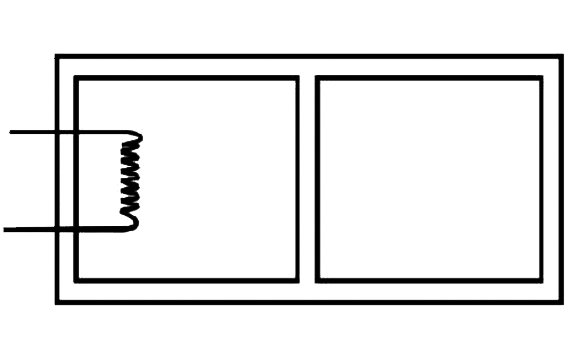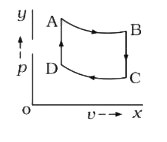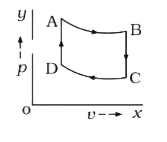On mole of a monoatomic ideal gas is taken through the cycle shown in figure .
: Adiabatic expansion : Cooling at constant volume
: Adiabatic compression : Heating at constant volume
The pressure and temperature at , etc, are denoted by etc., respectively . Given that . Calculate the following quantities: (i) The work done by the gas in the processs (ii) The heat lost by the gas in the process (iii) The temperature )
_E01_271_Q01.png) Solution in Gujrati
Solution in Gujrati
The correct Answer is:(i)
Given that
For Process
For process
(i)
(ii)
=
=
(iii) For process
For process
At end points A and D
_E01_271_S01.png)
Topper's Solved these Questions
- GEOMETRICAL OPTICSBOOK - ALLEN CHAPTER - GEOMETRICAL OPTICSEXERCISE - EXERCISE - 04 (B)
15 Videos
- GEOMETRICAL OPTICSBOOK - ALLEN CHAPTER - GEOMETRICAL OPTICSEXERCISE - EXERCISE - 05 (A)
73 Videos
- GEOMETRICAL OPTICSBOOK - ALLEN CHAPTER - GEOMETRICAL OPTICSEXERCISE - Comprehension Based Questions
66 Videos
- CURRENT ELECTRICITYBOOK - ALLEN CHAPTER - CURRENT ELECTRICITYEXERCISE - EX.II
66 Videos
- GRAVITATIONBOOK - ALLEN CHAPTER - GRAVITATIONEXERCISE - EXERCISE 4
9 Videos
Similar Questions
The rectangular box shown in Fig has partition which can slide without friction along the length of the box. Initially each of the two chambers of the box has one mole of a mono-atomic ideal gas (λ=5/3) at a pressure P0, volume V0 and temperature T0. The chamber on the left is slowly heated by an electric heater. The walls of the box and the lead wires of the heater is negligible. The gas in the left chamber expands pushing the partition until the final pressure in both chambers becomes 243P0/32. Determine (i) the final temperature of the gas in each chamber and (ii) the work done by the gas in the right chamber.

View SolutionAn aluminium sphere of 20cm diameter is heated from 0∘C to 100∘C. Its volume changes by (given that the coefficient of linear expanison for aluminium (αAl=23×10−6/0C)
View SolutionA certain amount of ice is supplied heat at a constant rate for 7 min. For the first one minute the temperature rises uniformly with time. Then it remains constant for the next 4 min and again the temperature rises at uniform rate for the last 2 min. Given Sice=0.5cal/g∘C,Lf=80cal/g.
The initial temperature of ice is
View SolutionIn the Bohr's model of hy drogen atom, the electron moves around the nucleus in a circular orbit of radius 5×10−11m. Its time period is 1.5×10−16s. The current associated with the electron motion is:-
View SolutionAssertion : The difference in the value of acceleration due to gravity at pole and equator is proportional to square of angular velocity of earth.
Reason : the value of acceleration due to gravity is minimum at the equator and maximum at the pole.
View SolutionOne mole of a monoatomic ideal gas is taken through the cycle shown in Fig: AtoB : adiabatic expansion BtoC : cooling at constant volume CtoD : adiabatic compression DtoA : heating at constant volume The pressure and temperature at A,B,etc. are denoted by P_A, T_A,P_B,T_B etc. respectively. Given that T_A=1000K , P_B=(2//3)P_A and P_C=(1//3)P_A , calculate the following quantities: (i) The work done by the gas in the process AtoB (ii) The heat lost by the gas in the process BtoC . (iii) The temperature T_D . [Given : (2//3)^(2//5)=0.85 ]
View SolutionOne mole of a monoatomic ideal gas is taken through the cycle shown in figure.
A→B Adiabatic expansion
B→C Cooling at constant volume
C→D Adiabatic compression.
D→A Heating at constant volume
The pressure and temperature at A,B etc., are denoted by pA,TA,pB,TB etc. respectively.
Given, TA=1000K, pB=(23)pA and pC=(13)pA. Calculate
(a) the work done by the gas in the process A→B
(b) the heat lost by the gas in the process B→C
Given, (23)0.4=0.85 and R=8.31J/mol−K
View SolutionOne mole of an ideal monoatomic gas is initially at 300K. Find the final temperature if 200J of heat are added as follows: (a) at constant volume (b) at constant pressure.
View SolutionIn adiabatic expansion of monoatomic ideal gas, if volume increases by 24% then pressure decreases by 40%.
Statement-2 : For adiabatic process PVγ = constant
View SolutionOne mole of a monatomic ideal gas is taken through the cycle shown in the figure: A to B adiabatic expansion B to C: cooling at constant volume C to D adiabatic compression D to C: heating at constant volume. The pressure and temperature at P_A, P_B etc. T_A , T_B etc. are denoted etc. respectively. Given that T_A = 1000 K, P_B =(2 //3)P_A and P_C = (1 //3)P_A Calculate the following quantities. The work done by the gas in process A to B (in J)
View SolutionOne mole of a monatomic ideal gas is taken through the cycle shown in the figure: A→B adiabatic expansion

B→C: cooling at constant volume
C→D adiabatic compression D→C: heating at constant volume.
The pressure and temperature at PA,PB etc. TA,TB etc. are denoted etc. respectively. Given that
TA=1000K,PB=(2/3)PA and PC=(t/3)PA
Calculate the following quantities.
The heat lost by the gas in process B→C (in J)
View SolutionOne mole of a monatomic ideal gas is taken through the cycle shown in the figure: A→B adiabatic expansion

B→C: cooling at constant volume
C→D adiabatic compression D→A: heating at constant volume.
The pressure and temperature at PA,PB etc. TA,TB etc. are denoted etc. respectively. Given that
TA=1000K,PB=(2/3)PA and PC=(1/3)PA
Calculate the following quantities.
The temperature TD (in K) [Given : (25)2/5=0.85 ]
View SolutionIn an adiabatic expansion of an ideal gas the product of pressure and volume .
View SolutionA cycle followed by an engine (made of one mole of an ideal gas in a cylinder with a piston) is shown in figure. Find heat exchanged by the engine, with the surroundings for each section of the cycle. CV=32R

(a) A to B : constant volume
(b) B to C: constant pressure
(c) C to D: adiabatic
(d) D to A: constant pressure
View SolutionOne mole of a monoatomic ideal gas is taken through the cycle shown in figure.
A→B Adiabatic expansion
B→C Cooling at constant volume
C→D Adiabatic compression.
D→A Heating at constant volume
The pressure and temperature at A,B etc., are denoted by pA,TA,pB,TB etc. respectively.
Given, TA=1000K, pB=(23)pA and pC=(13)pA. Calculate
(a) the work done by the gas in the process A→B
(b) the heat lost by the gas in the process B→C
Given, (23)0.4=0.85 and R=8.31J/mol−K
View SolutionOne mole of an ideal monoatomic gas is initially at 300K. Find the final temperature if 200J of heat are added as follows:
(a) at constant volume (b) at constant pressure.
View Solution
